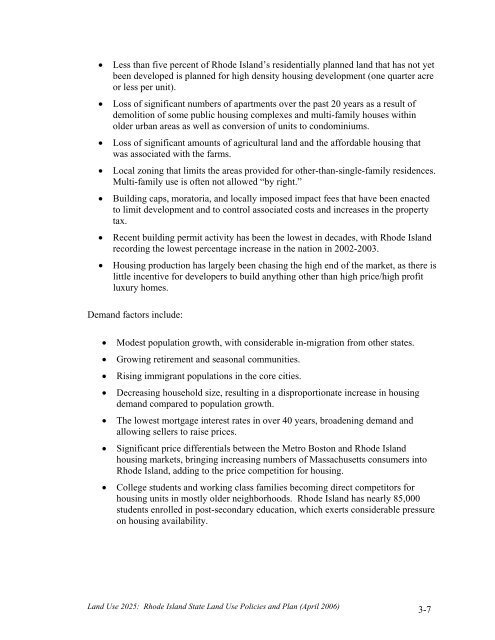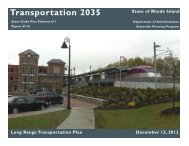Land Use 2025 - RhodeMap RI
Land Use 2025 - RhodeMap RI
Land Use 2025 - RhodeMap RI
- No tags were found...
You also want an ePaper? Increase the reach of your titles
YUMPU automatically turns print PDFs into web optimized ePapers that Google loves.
• Less than five percent of Rhode Island’s residentially planned land that has not yetbeen developed is planned for high density housing development (one quarter acreor less per unit).• Loss of significant numbers of apartments over the past 20 years as a result ofdemolition of some public housing complexes and multi-family houses withinolder urban areas as well as conversion of units to condominiums.• Loss of significant amounts of agricultural land and the affordable housing thatwas associated with the farms.• Local zoning that limits the areas provided for other-than-single-family residences.Multi-family use is often not allowed “by right.”• Building caps, moratoria, and locally imposed impact fees that have been enactedto limit development and to control associated costs and increases in the propertytax.• Recent building permit activity has been the lowest in decades, with Rhode Islandrecording the lowest percentage increase in the nation in 2002-2003.• Housing production has largely been chasing the high end of the market, as there islittle incentive for developers to build anything other than high price/high profitluxury homes.Demand factors include:• Modest population growth, with considerable in-migration from other states.• Growing retirement and seasonal communities.• Rising immigrant populations in the core cities.• Decreasing household size, resulting in a disproportionate increase in housingdemand compared to population growth.• The lowest mortgage interest rates in over 40 years, broadening demand andallowing sellers to raise prices.• Significant price differentials between the Metro Boston and Rhode Islandhousing markets, bringing increasing numbers of Massachusetts consumers intoRhode Island, adding to the price competition for housing.• College students and working class families becoming direct competitors forhousing units in mostly older neighborhoods. Rhode Island has nearly 85,000students enrolled in post-secondary education, which exerts considerable pressureon housing availability.<strong>Land</strong> <strong>Use</strong> <strong>2025</strong>: Rhode Island State <strong>Land</strong> <strong>Use</strong> Policies and Plan (April 2006) 3-7
















